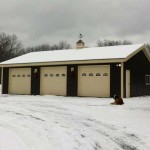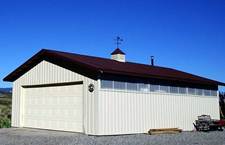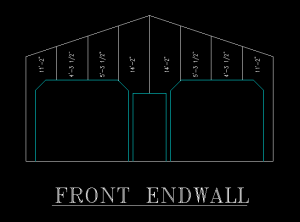Where, oh Where, to Place Overhead Doors
My long term readers may have believed I have pounded overhead doors to death. Ha! I say – there is always more to talk about when it comes to overhead doors!
We’ve talked about door widths, avoiding 8 and 14 foot width doors as they are not usually the most practical design solutions.
Then there is door spacing – three feet from a corner and three feet in between being the happiest for prevention of door dings and being able to utilize precious wall space.
 What prompted this article was a recent request for a price quote on a new post frame building from one of our clients. He writes, “I want a 28 ft. x 32 ft. x 10 building. I want a 9 ft. door and a 16 ft. door in the north 32 ft. side.”
What prompted this article was a recent request for a price quote on a new post frame building from one of our clients. He writes, “I want a 28 ft. x 32 ft. x 10 building. I want a 9 ft. door and a 16 ft. door in the north 32 ft. side.”
As requested with the 28 foot being the width and 32 feet being the sidewall length, an interesting phenomenon is probably going to occur.
Imagine, if you will, precipitation. Be it snow or rain, it is going to come off of the 32 foot eave sides and either run down one’s neck, or pile up on the ground in front of the doors.
I happen to know this building is to be located where the white stuff (when it falls) is not light and fluffy, it is more like white concrete. And when it comes, it is not unusual to see six or eight inches of it.
Let’s say, for sake of discussion, there is a six inch snowfall. The snow builds up on the roof until whoosh, bang – it is now in a nice not so neat pile on the ground in front of the overhead door. The pile being somewhere in the vicinity of three feet wide and two feet high, and way too heavy to easily shovel out of the way.
Not a fun picture.
 Now, leave the four corners of the building exactly where they were previously, and spin the roof 90 degrees. Now the overhead doors are in the 32 foot wide gable endwall. When the snow slides off, it slides to each side and only the snow which naturally falls on the ground has to be dealt with, not a roof’s worth.
Now, leave the four corners of the building exactly where they were previously, and spin the roof 90 degrees. Now the overhead doors are in the 32 foot wide gable endwall. When the snow slides off, it slides to each side and only the snow which naturally falls on the ground has to be dealt with, not a roof’s worth.
Considering a new post frame building with overhead doors? If so, look at how you might place the doors so as to avoid extended shovel duty. You will be glad you did!








